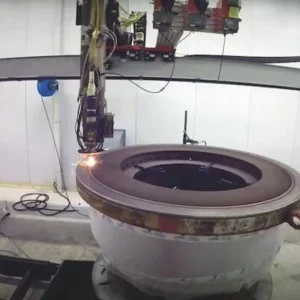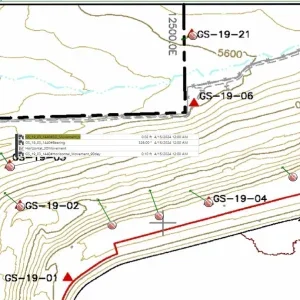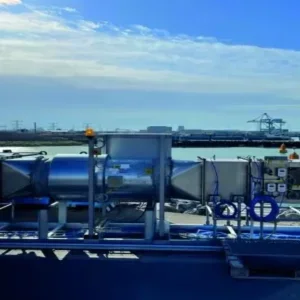
Silt sedimentation is an important phenomenon, which has a significant impact on the lifespan of reservoirs. A number of research projects have been conducted concerning reservoir sedimentation and downstream scouring during planning, designing and construction of the Three Gorges project to address sediment-related issues.
The river stretch from the headwaters to Yichang City is known as the Upper Reaches of the Yangtze river, with a catchment area of 1Mkm2, or 55% of the Yangtze river’s total. Along this river stretch, important tributaries such as Minjiang, Tuojiang, Jianling, Hengjiang, Chishui and Wujiang rivers and others flow into the main stem. The Yichang hydrometric station is located at a distance of 40km downstream of the Three Gorges hydro project and water flow and silt concentration variations measured by this station are representative for the Three Gorges reservoir, with silt load coming mainly from the Jinsha, Jialing, Minjiang, Tuojiang and Wujiang rivers and mainstream sections located in between. In the past, studies of original data of water flow and silt load were obtained from hydrological measurements before the 1980s. However, recent studies of the water flow and silt load upstream of the Three Gorges reservoir demonstrate significant changes compared with the past, with comparatively small changes of water flow and quite obvious reductions of silt load. Changes of sediment transport from the upstream stretch of the Yangtze river will have a large impact on the operation of Three Gorges reservoir.
Caused by both natural and human factors, some specific changes have taken place in water flow and sediment transport on the Upper Reaches of the Yangtze, and the Jialing river has witnessed a significant silt load reduction. Specific features and variation trend of water flow and sediment transport of the upper Yangtze river are studied and analysed here, using measured data from key hydrometric stations located on upstream river sections. Holding sediments assesses the roles of upstream reservoirs in silt load reduction. There are some other causes leading to silt load reduction, including water and soil conservation programmes and human activities, and these causes require additional studies in the future.
Discharge and sediment transport
Statistical data of measured water runoff and sediment transport at main hydrometric stations on the upper Yangtze over a number of different years are given in Table 1. It can be seen from the table that there are no apparent water runoff variations for Yichang and Wanxian hydrometric stations, but there has been significant stilt load reductions at those stations in recent years. For the upstream Cuntan hydrometric station located on the main stem of the Yangtze river, the measured annual average sediment transport has witnessed significant reductions which is caused by the important reductions recorded by the Beipei hydrometric station on the Jialing river, a left bank tributary of the Yangtze. Other tributaries such as the Minjiang and Wujiang rivers also demonstrate reduced sediment transport.
In order to present a clear reduction trend of the annual sediment transport, dual accumulation curves of mean annual water runoff and mean annual sediment transport are drawn for Pinshan (Jinsha river), Gaochang (Minjiang river), Beipei (Jialing river) and Wulong (Wujiang river) hydrometric stations.
Pinsha
Figure 1 shows the dual accumulation curve for Pinshan station on the Jinsha river. It can be seen that from 1990 to 2002 some years witnessed large water runoff and large sediment transport, and after 2000 there is a trend for the curve’s gradient to decrease, but this silt load reduction trend is not obvious.
Gaochang
Figure 2 shows the dual accumulation curve for Gaochang station on the Minjiang river. Since 1993 the curve has the smallest gradient, demonstrating the silt load reduction trend for the river. In the recent period, the annual water runoff of Minjiang river does not vary significantly while its annual sediment transport reduces by about 20.7% compared with the mean annual value.
Beipei
Figure 3 shows the dual accumulation curve for Beipei station on the Jialing river. The curve’s gradient decreases clearly over the years, which leads us to two conclusions. First, the annual sediment transport of Jialing river has reduced significantly over recent years, and secondly the sediment reduction is larger than that of the water runoff. The measured annual water runoff and sediment transport in recent years is correspondingly 82.2% and 29.4% of that measured in the 1950s, 73.9% and 28.6% of that measured in the 1960s, 91.7% and 40.7% of that measured in 1970s and 72.4 and 31.1% of that measured in the 1980s. Since 1984 the annual sediment transport of Jialing river reduced continuously, and the measured annual sediment transport in recent years witnessed a reduction by 63% compared with the mean annual value over a longer period.
Wulong
Figure 4 shows the dual accumulation curve for Wulong station. Since 1984 the curve’s gradient decreases obviously which indicates the significant reduction of the annual sediment transport. The calculated annual sediment transport for recent years decreased by 28% compared with the mean annual value over a long period.
Yichang
The Upper Yangtze and its tributaries do not show large variations of annual runoff in recent years, yet all tributaries demonstrate an obvious reduction of annual sediment transport, which causes a reduction trend of annual sediment transport in the Yangtze river at Yichang hydrometric station as Figure 5 shows. Since 1988, the annual average sediment transport at Yichang station is about 50.5% less than the mean annual value of the Yangtze river measured here. This fact means that the silt amount brought into the Three Gorges reservoir after it’s impounding will decrease significantly.
Spearman rank order correlation verification of flow and sediment variations
The correlation relationship of measurement series with time t is analysed with the rank order of measurement series of annual water runoff (or annual sediment transport) presented by Mi and the rank order of time series presented by Ti. The analysed correlation relationship r is calculated using the following formula:

Where N represents the series length, or the number of measurement years. It is obvious when the rank order Mi is close to Ti, the rank order correlation relationship r has a large value to demonstrate the evident trend. From a=0.05 the critical value c=u0.975/vN-1 is obtained, where u0.975=1.96. Different variation scenarios Mi in relation with valuation r are defined as follows:
lrl>c means that the variation trend is apparent.
0.8c=lrl=1.0c means that the variation trend is apparent.
0.6c<lrl<0.8c means that the variation trend is not so apparent.
lrl=0.6c means that the variation trend is not apparent.
The rank order correlation values for annual water runoff and annual sediment transport at main control hydrometric stations of the Upper Yangtze are calculated with the use of formula (1) and measurement data series shown in Figures 1 to 5. All calculated values are given in Table 2. Three findings can be made from examining Table 2: (1) the annual water runoff and annual sediment transport recorded at Gaochang hydrometric station demonstrate a comparatively apparent trend of reduction; (2) the annual water runoff and annual sediment transport recorded at Beipei and Yichang hydrometric stations demonstrate an apparent trend of reduction; (3) the annual water runoff recorded at Cuntan and Wulong hydrometric stations demonstrate no trend of variation while the annual sediment transport recorded at these two stations show an apparent trend of reduction.
Discharge and sedimentation changes
Based on the dependence relation statistical study of measured annual water runoff and annual sediment transport at the main hydrometric stations upstream of Yichang in the period from 1990 to 2002, the following dependence relations are obtained between the annual runoff and annual sediment transport for different hydrometric stations on the Upper Yangtze and its tributaries:
Gaoyang station on Minjiang river: Ws = 18.9W – 12100 (2)
Beipei station on Jialing river: Ws = 35W – 14000 (3)
Wulong station on Wujiang river: Ws = 10.4W – 3200 (4)
Yichang station on Yangtze river: Ws = 20W – 47000 (5)
The above dependence relations are judged to be rational after symbol verifications and departure value verification.
Sediment interception of reservoirs – upstream area
According to the study results obtained from the sediment and silt research completed for the Three Gorges project during the 9th five-year plan period, there were 11,931 large to small-sized reservoirs constructed before the end of the 1980s on the Yangtze river and its tributaries upstream of Yichang, with a total storage volume of 20,504Mm3. The number of reservoirs completed in the decades before 1990 and their cumulative storage are given in Table 3, while silting-up status in the late 1980s is shown in Table 4.
It can be seen from the tables that the 1970s witnessed a reservoir construction boom on the Upper Yangtze upstream of Yichang and in the 1980s the annual average sedimentation volume of all reservoirs on the Upper Yangtze was equal to 138.87Mm3. In the late 1980s the silt reduction process reached Yichang hydrometric station.
Silt-holding of operating reservoirs has a dual impact on the downstream sediment transport. On one hand, it reduces the silt volume released to downstream river sections. On the other hand however, clear water released by the reservoir has a large capacity to carry silts and some silt concentration can be re-established through flow scouring. Taking this dual impact into consideration, some efforts are made to assess the sedimentation impact coefficient due to the silt-holding process by reservoir aggregation in a given catchment area. In this assessment, a large key silt-holding reservoir is taken as the start point, data from reservoir sedimentation measurements and sediment transport data of downstream hydrometric stations are first included in the analysis, then the silt-holding function of all downstream reservoirs along the river course is considered. Finally the river flow’s silt recarrying due to river bed scouring is incorporated to calculate the resultant silt reduction at the selected terminal hydrometric station. In such a way the silt-holding sediment reduction by an aggregation of reservoirs in the catchment area can be evaluated.
The sedimentation impact coefficient a due to silt-holding by an aggregation of reservoirs can be calculated with the formula,

where WRR is sedimentation volume as a result of silt-holding by an aggregation of reservoirs; WSE is the river flow’s silt recarrying due to river bed scouring.
The sedimentation volume caused by cascaded reservoirs’ silt holding can be calculated with the following formula,

where WSE.(i-1) is the river flows silt recarrying due to river bed scouring occurring on the river section from i-1th reservoir to i-th reservoir after impounding of the i-1th reservoir; Wdi, Wd.(i-1) are the silt releases from the i-th reservoir and the i-1-th reservoir respectively; ?Wi is the lateral silt input on the river section from the i-th reservoir to i-1-th reservoir, and WRRi is the sedimentation volume of the i-th reservoir.
The sedimentation volume caused by single reservoir silt-holding can be calculated with the following formula,

Where WSE is defined the same as that in above formula, Wd.st is sediment transport measured at the hydrometric station downstream of the reservoir; WdR is silt release through the reservoir, and ?WS is the lateral silt input on the river section from the reservoir to the downstream hydrometric station.
Variation of the sedimentation impact coefficient due to silt-holding by an aggregation of reservoirs in relation with distances along the river course can be expressed as follows,

Where L is the distance along river course; C and f are a parameter and a function respectively which are defined by many factors and can be calculated with measurement data.
For Jialing river and the Upper Yangtze, the modulated sedimentation impact coefficients is,
a (%) = 89.686 x 1.0026-L
For other tributaries the above coefficient is,
a (%) = 97.82 x 1.0022-L
Using the above-mentioned formulae, calculations are made to assess the reservoir sedimentation impact caused by reservoir aggregations on the Jinsha, Minjiang, Tuojiang and Jialing rivers and on the main stem of the Yangtze river, with relation to Cuntan hydrometric station. In those calculations distances between gravity centers of reservoir aggregations in all catchment areas and Cuntan hydrometric station are included and put in relevant sedimentation impact coefficient formulae to calculate different values relating to Cuntan station. On this basis, the silt reductions at Cuntan hydrometric station caused by relevant reservoir aggregations are determined first and then the total silt reduction amount at Cuntan station is summed up, as shown in Table 5.
Through sedimentation impact analyses made for Cuntan and Wulong hydrometric stations, it is estimated that the annual sediment input into Three Gorges reservoir is reduced due to upstream reservoir silt-holding annually by 15.10 to 18.82M tons, or 14% to 17.3% of 113M tons of the annual sedimentation volume of existing reservoir aggregations on the Upper Yangtze and its tributaries.
Conclusions
Based on hydrological and sediment measurement data made available by the main control hydrometric stations on the Upper Yangtze and its tributaries, a preliminary study and analysis was carried out by the author to discover features, trend and causes of recent flow and sediment variations on the river. The main conclusions of this study are:
• Over the recent period, the annual flow on the Upper Yangtze and its tributaries varies very insignificantly as recorded by upstream hydrometric stations, except for a slight flow increase recorded at Wulong station and a slight decrease recorded at Beipei station, but the annual sediment transport decreases quite obviously at all hydrometric stations. Compared with the period before 1990, the annual sediment transport decreases by 27.4% at Gaochang station on the Minjiang river, 69.3% at Beipei station on the Jialing river, 33.6% at Wulong station on the Wujiang river and 23.8% at Yichang station on the main stem of Yangtze.
• It is found that the silt reduction impact coefficient is related to sedimentation of upstream reservoirs on one hand and to downstream distance for the river flow to scour and to recarry silts along the river course on the other. Statistical calculations show that silt reduction caused by reservoir sedimentation on the Upper Yangtze is about 14.4% to 17.3% of the total measured sedimentation volume of all upstream reservoir aggregations.
• Silt holding by hydro projects on the upper reaches of the Yangtze river is one of the causes leading to sediment reduction. Other causes include variations of rain-fall regime, water and soil conservation programmes, human activities, river bed sediment flashing, river bed sand dredging and others which require study in the future.
Author Info:
Dai Huichao, Deputy Director of Science Technology and Environmental Protection Department. China Three Gorges project Corporation. Email: dai_huichao@ctgpc.com.cn. Tel: +86 717 6767150. Fax: +86 717 6762204
Related Articles
Three Gorges dam completed
Tables
Table 1
Table 2
Table 3
Table 4
Table 5






